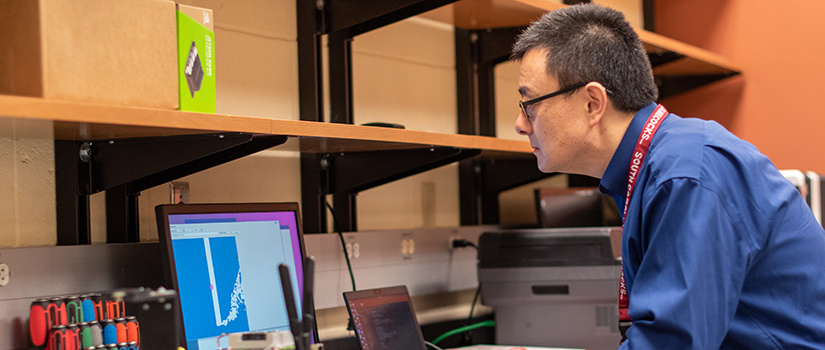NASA grant will allow for more efficient aerostructural control
By Leigh Thomas | July 7, 2020
As today’s aircraft grow thinner and lighter to allow for greater fuel efficiency, University of South Carolina Associate Professor Yi Wang is developing technology to ensure safety is not sacrificed as cost efficiency of aircraft production is increased. His advanced computational methods will allow for greater aerostructural control through real-time simulation.
Wang is collaborating with Kapil Pant of CFD Research Corporation on the NASA Small Business Innovation Research (SBIR) grant.
Wang explains that the project will examine “flutter,” or the interaction that occurs between an in-flight aircraft and the wind as wind-induced vibrations become larger and match the natural frequency of the vehicle. This phenomenon can damage the vehicle and create safety issues, even failure of the aircraft.
"Dr. Wang’s pioneering technology will help us build fast models, enabling simulation at real-time speed and giving us greater applicability to control and optimization.”
- Kapil Pant, CFD Research Corporation
Historically, the computational time required to model flutter has been significant—it can take weeks or even months of analysis. Wang and Pant are looking at methods to minimize the computational time necessary to achieve aerostructural control down to minutes and disseminate the technology for real-world application.
Wang said, “The issue is that the approach has to be hand-crafted by experienced engineers. Only they know the physics and design of vehicle. We want to overcome barriers between the emergent technology and the end-user by developing an intelligent framework and algorithms that will generate the model automatically and rapidly with minimum requirement of domain expertise. Any engineer or student will be able to use data from simulations and experiments and create a model to analyze flutter within minutes or one day.”
According to Pant, newer aircrafts are made with lighter, more flexible materials for greater fuel efficiency at high speeds. However, this efficiency comes with a different set of limitations, in that flutter is created at high speeds, introducing instability to the aircraft.
“What we are trying to do is to mitigate the instability by controlling it,” says Pant. “One method is through model-based control, but current models are large and can’t be used for real-time control. Dr. Wang’s pioneering technology will help us build fast models, enabling simulation at real-time speed and giving us greater applicability to control and optimization.”
Pant explains that the role of CFD Research Corporation is to, once jointly developed, package and deliver these capabilities to customers, consisting of NASA, other government agencies, government contractors and private corporations.
NASA’s grant award for phase two of this project was for $750,000 and began in August 2019. A two-year effort, this phase is expected to conclude in 2021, but Wang anticipates that research on this technology will continue beyond phase two.
Wang is an associate professor of mechanical engineering in the College of Engineering and Computing. His research interests include computational and data-enabled science and engineering (CDS&E) and its applications in multiphysics and multiscale systems engineering, including fluid structural interaction, microfluidics/nanofluidics, thermal and energy management and additive manufacturing, among others. One way these interests are being applied is through research sponsored by the U.S. Army and U.S. Air Force. Wang is studying the use of models to predict thermal signature of grounded vehicles, to develop unmanned autonomous systems, to plan flight tests and to evaluate systems performance.
